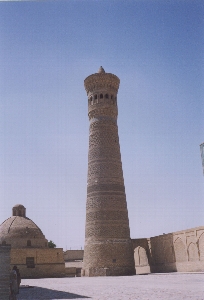The Mongols and their legacy
Repeated Mongol invasions brought devastation to Central Asia from 1218 to 1258, when a final large-scale invasion by Hulegu led to the establishment of the Il-Khanate of Persia and relative stability. Close ties between the Il-Khans and the Mongol Yuan Dynasty of China restored commerce along the Central Asian crossroads, while the Chaghatay khans allowed Central Asia to split into two halves, the sedentary Muslim Transoxiana to the southwest and the nomadic pagan Mogholistan to the northeast. The majority population in today’s Central Asia, the Uzbeks and the Kazaks, are descendants of the western Mongol kingdom known as the Golden Horde, which ruled over Russia and the Volga river basin.
Conquest
The Mongols began their invasion of Central Asia in 1218, destroying the towns of Samarkand, Bukhara, Urgench and Balkh, among many others. Because Chingis Khan (ca. 1167–1227) was on a mission of vengeance against the ruler of Khwarezm rather than a mission of revenue-generating conquest, he gave his army free rein to destroy as they liked. They burned down Bukhara, massacred the defenders of the citadel, and assaulted women, children, and old men. One of the few structures in Bukhara to survive the attack was the great Kalon minaret. Any town that did not surrender immediately faced total destruction. The Mongols systematically slaughtered all inhabitants, and sometimes all animals as well. Mass slaughter was followed by pillage and arson. The Muslim inhabitants of the region had never witnessed or even imagined this level of destruction before. The Mongol conquest and destruction of the Abbasid Caliphate in Baghdad (1258) set off a profound social and theological crisis that Muslims today still discuss.
The khanates
Chingis Khan divided his vast empire into sub-kingdoms for his sons, including territories in western Eurasia and the Middle East that the Mongols had not yet conquered. The youngest son, Tolui, inherited the central Mongol lands from which his descendants expanded to found the Yuan Dynasty in China (1260–1370) and the Il-Khanate of Persia (1258–1335). The oldest son Jochi was given the western lands but since he pre-deceased Chingis, Jochi’s son Batu carried out the invasion and founded the Golden Horde (1240–1480). The second son, Chaghatay, ruled over Transoxiana (the “land between the rivers” Oxus/Amu Darya and Jaxartes/Syr Darya). However, his descendants did not build a centrally-organized kingdom.
In all of these cases, the Mongol ruling elite was absorbed into local populations. They adopted local languages, married into local families, became sedentary and converted to Islam, Buddhism, and Nestorian Christianity. The partial exception to this pattern was the Golden Horde, which did not settle to live among their Russian subjects or adopt Russian Orthodox Christianity. However, they were absorbed into the nomadic Turkic and Muslim peoples living in the steppes of southern Eurasia. From the 14th century on, the ruling dynasties across Eurasia were Turko-Mongol or Perso-Mongol in ethnic and linguistic makeup. In Transoxiana Iranian language and style dominated the bureaucracy and arts, although Turkic was the common spoken language.
This great mixing and matching of cultures did not mean the disappearance of a distinct Mongol identity. In the arena where it mattered most—political power—proving direct descent from Chingis Khan was the only way a ruler could legitimately claim the title of “khan.” Ambitious warriors who were not members of the “Golden Kin” (as the direct descendants were called) had to be content with the title of “sultan” or “emir.” Hence Tamerlane (Timur Lang, 1336–1405), one of the last great conquerors out of Central Asia, was a Turko-Mongol emir, but not a khan. He was Muslim, but combined nomadic/pagan Turko-Mongol and settled/Islamic Arabo-Persian legal structures as seemed practical (although his empire was never well-organized, and fell apart on his death except in Transoxiana itself). Mongol genealogical identity remained strong in Central Asian ruling dynasties until the early 20th century, even as the passage of time made proof of that identity less possible or relevant.
Who were these Turkic peoples?
The first identifiable Turkic-speaking nomadic tribes were discussed in Chinese court histories in the fifth century CE. The Turkic languages, which share a common ancestor with Mongol, belong to the larger Altaic family of languages. In comparison, Farsi (Persian) belongs to the Indo-European family and Arabic belongs to the Afro-Asiatic family. Turks rapidly spread west and inhabited lands from the Tarim Basin to Egypt for centuries before the Mongol invasions. Turkic nomads in the west Eurasian steppes (Pechenegs and Polovtsy) and along the Volga River (Bulgars) were strong rivals of the earliest Russians until the Mongols crushed them all in the 13th century.
Over time and distance the original Turkic language split into different families, related but no longer mutually intelligible. The names of these language sub-groups are handy for hanging identification labels on. Southwest of Transoxiana the tribes given the generic name of “Turkmen” or “Turkoman” speak Oghuz Turkic; the people living in today’s Azerbaijan and Turkey also speak languages in this group. To the north Kazakhs, Kyrgyz, Karakalpaks, Tatars and Bashkirs speak Qipchaq Turkic. In the center of Transoxiana Uzbeks and Uyghurs speak what is called Chaghatay or Karluk Turkic.

